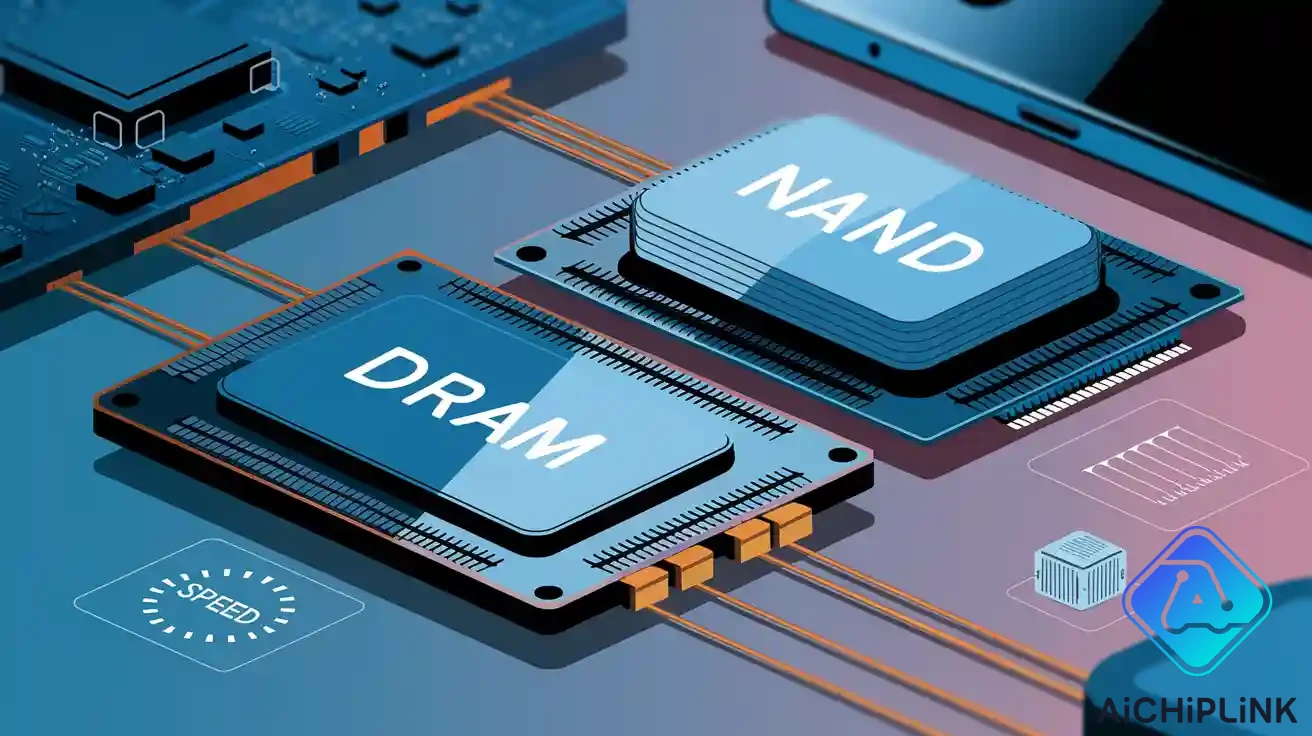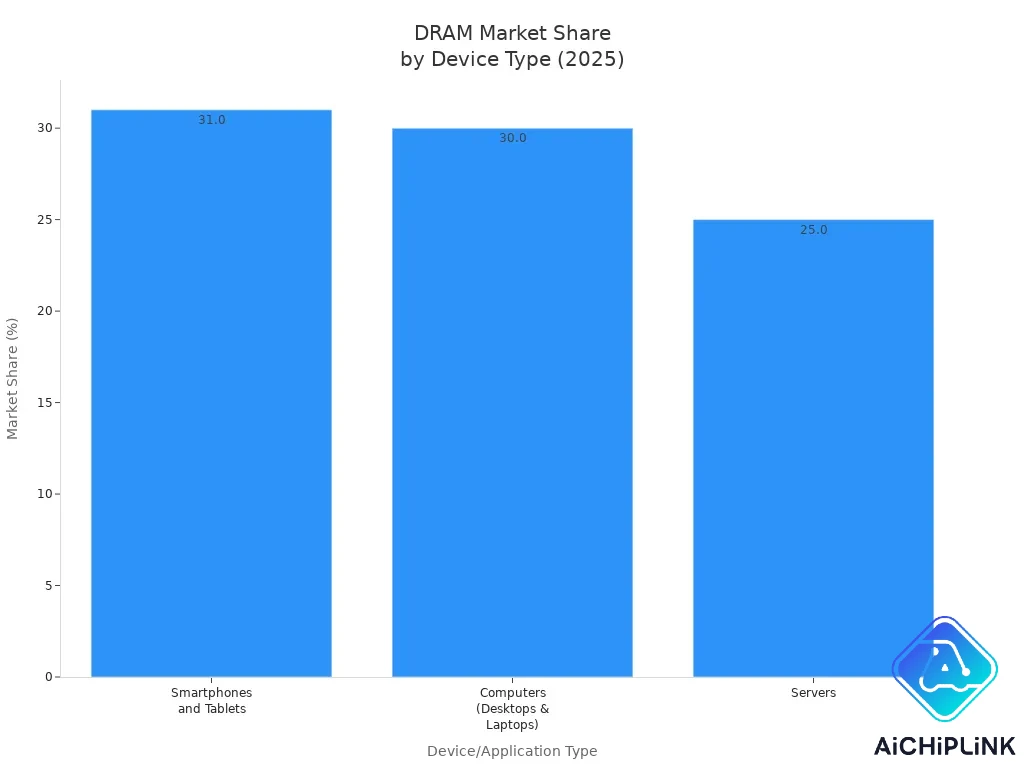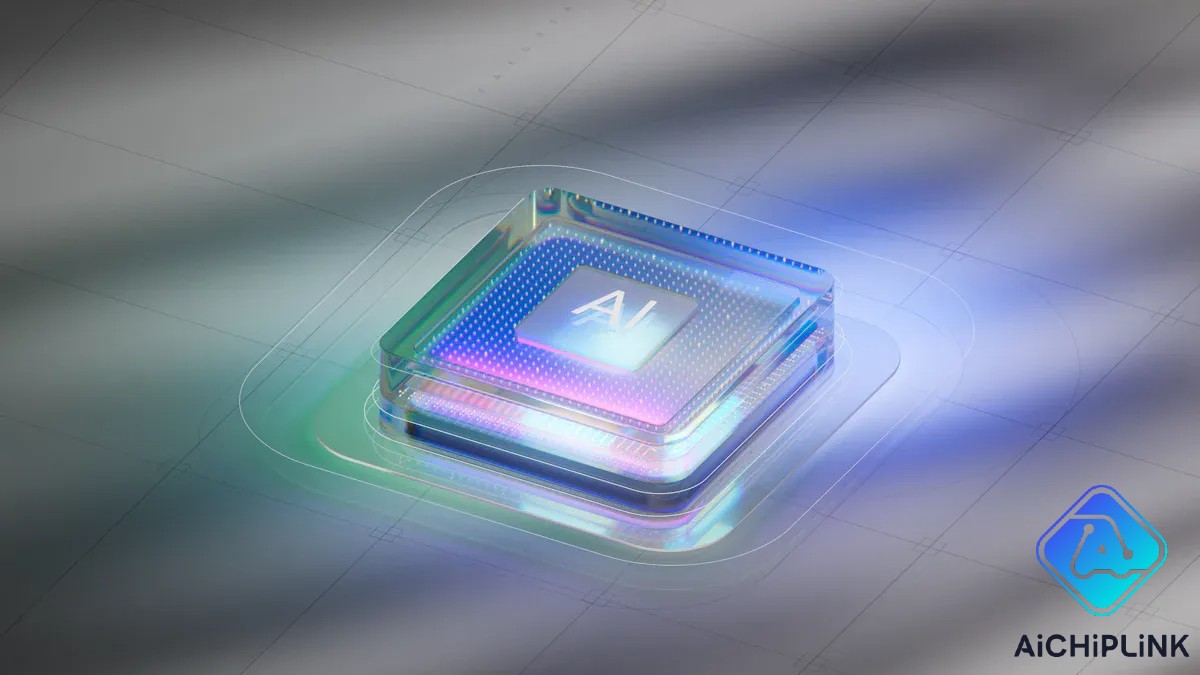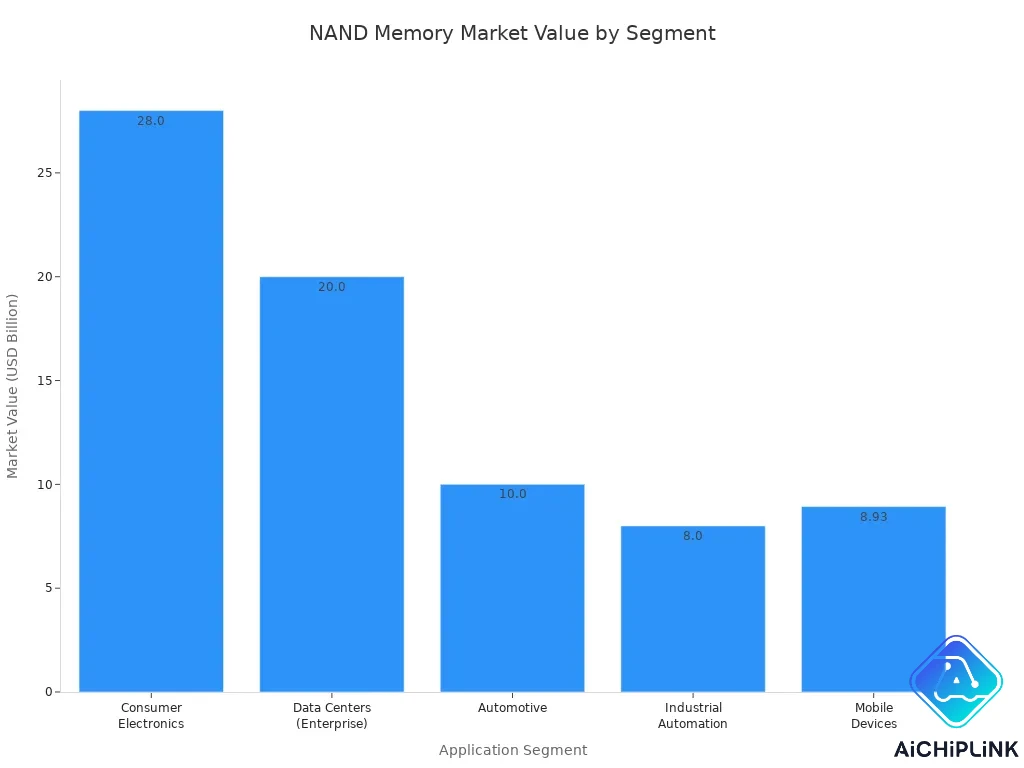
DRAM means Dynamic Random Access Memory. It holds data that computers need fast. NAND is a kind of flash memory. It saves information even when power is off. DRAM and NAND are important in phones and laptops. They are also used in data centers. People need memory for quick processing. Storage keeps files safe. In the last ten years, demand for DRAM and NAND has changed. New technology and world events caused this. Knowing about these memories helps people choose devices wisely.
Key Takeaways
-
DRAM is a fast type of memory. It holds data only while the device is on. This makes it good for running programs and quick jobs.
-
NAND is a storage memory. It keeps data safe even when the power is off. It is great for saving things like photos and apps.
-
DRAM costs more money and needs to be refreshed all the time. But it gives faster access and better performance for real-time tasks.
-
NAND costs less, can store more data, and lasts a long time. But it is slower and can wear out after many writes.
-
Devices use both DRAM and NAND together. This helps balance speed and storage. It lets phones, computers, and data centers work well.
DRAM Memory
What is DRAM?
Dynamic random-access memory, or DRAM, is in almost all modern devices. DRAM keeps data as tiny electrical charges. Each DRAM chip cell has a capacitor and a transistor. These parts store one bit of data. DRAM is called "dynamic" because it needs to refresh often. If it does not refresh, the data fades away. DRAM is volatile. This means it loses all data when power is off.
DRAM is popular because it can store lots of data and is not expensive. That is why computers and phones use it for main memory.
How DRAM Works
DRAM chips read, write, and refresh data many times each second. The capacitor holds a charge for a 1 or 0. The transistor works like a switch. It lets the chip get or change the charge. The charge leaks out fast, so the chip must refresh every cell about every 64 milliseconds. Refreshing uses a little time but is very important for keeping data safe.
| Characteristic | Explanation |
|---|---|
| Volatile Memory | DRAM loses its data if the power goes off. |
| Memory Cell Structure | Each cell has a capacitor and a transistor. |
| Refresh Requirement | Cells need refreshing every few milliseconds because the charge leaks. |
| Organization | Memory cells are set up in rows and columns like a grid. |
| Random Access | Any spot in memory can be reached right away. |
| Speed and Cost Trade-off | DRAM is slower than SRAM but costs less and uses less power. |
| Dynamic Nature | Data is kept as charges that leak, so refresh is needed. |
| Usage | Used for temporary storage near the CPU for quick access. |
DRAM Uses
DRAM chips are the main memory in computers, smartphones, and servers. DRAM is used a lot in mobile devices, computers, and data centers. In 2025, smartphones and tablets will use about 31% of DRAM. Computers will use about 30%. Servers will use about 25%. More cars and factories are also starting to use DRAM.

DRAM Pros and Cons
DRAM has some good points:
-
It can hold a lot of data on one chip.
-
It gives fast data access compared to hard drives.
-
It is not too expensive for most computers.
-
It works with many types of computers.
But DRAM also has some bad points:
-
It is volatile, so data is lost if power goes out.
-
It needs to refresh all the time, which uses more power and makes heat.
-
It is slower than SRAM and can have errors if refresh fails.
DRAM is still very popular because it balances speed, cost, and how much data it can hold. Devices need more memory for new features, so DRAM is in high demand.
NAND Memory

What is NAND?
NAND is a kind of storage that keeps data safe when power is off. DRAM loses data if you unplug it, but NAND does not. This makes NAND good for saving things for a long time. NAND flash memory uses floating-gate transistors. These special parts trap electric charges to hold bits of data. Toshiba made NAND in 1989. It soon became the main way to store data in many gadgets. Now, NAND chips are found in phones and cameras.
NAND has some important features. It can store a lot of data in a small space. It writes and erases data quickly. You can use it again and again. NAND is cheap and works well. That is why people use it for most storage today.
How NAND Works
NAND memory uses floating gate and control gate transistors to store data. To write data, the chip uses high voltage to move electrons into the floating gate. To erase data, it takes the electrons out. If electrons are there, the bit is a 1. If not, it is a 0. NAND cells are lined up in a row. This lets the chip hold more data in less space. Newer NAND stacks cells in layers. This is called 3D architecture. Stacking makes the chip hold even more data. Charge trap technology in 3D NAND helps keep data safe by stopping cells from bothering each other.
| Aspect | Floating Gate Transistor | Charge Trap Flash (3D NAND) |
|---|---|---|
| Charge Storage Location | Insulated conducting layer | Non-conductive material in discrete spots |
| Charge Retention Mechanism | Charge held in floating gate | Charge trapped in sites, better retention |
| Data Retention | Can leak over time | Improved, holds charge longer |
| Impact Factors | Age, wear, temperature, chip quality | Same, but better insulation |
NAND Uses
NAND memory is used in many things that need to keep data safe. Phones and tablets use NAND to store photos, apps, and videos. In 2024, these devices used about 31.4% of all NAND memory. Laptops, smart TVs, and cameras also use NAND for fast storage. Solid state drives use NAND instead of old hard drives. This makes computers faster and stronger. Data centers and cloud services use NAND to store lots of data and get it quickly. Cars use NAND in electric vehicles and safety systems. Factories and smart devices use NAND because it holds a lot and works well.

NAND Pros and Cons
NAND has many good points as storage. It can hold a lot of data and costs less. It works fast. 3D NAND lets one chip store even more data. Error correction and wear-leveling help keep data safe for a long time. But NAND has some problems too. Each chip can only be written and erased so many times before it wears out. Data may not last as long if you use it a lot or if it gets hot. Chips with more data, like QLC, do not last as long as simple ones. Still, NAND is the best choice for most storage in gadgets and big computers.
DRAM vs NAND
Performance
DRAM and NAND do different jobs in computers. DRAM is much faster than NAND. It can read and write data very quickly. This is because DRAM uses charge in capacitors to get information fast. Tests show DRAM is better than NAND, especially when writing data. NAND has to erase whole blocks before it can write new data. This makes NAND slower. DRAM can write data in a more flexible way. That is why DRAM is picked for fast storage and real-time work.
| Feature | DRAM | NAND |
|---|---|---|
| Speed | Very fast (nanoseconds) | Slower (microseconds) |
| Volatility | Volatile (needs power) | Non-volatile (keeps data) |
| Access Method | Random access | Block-based access |
| Endurance | High (many cycles) | Varies by type (SLC > QLC) |
NAND keeps data safe even if the power goes out. This makes NAND good for saving things for a long time. But NAND is not as fast as DRAM. In big computer centers, DRAM does quick jobs. NAND stores lots of data.
Cost and Capacity
DRAM and NAND have very different prices. DRAM costs about $5.41 for each gigabyte. NAND only costs $0.36 for each gigabyte. This means DRAM is about 15 times more expensive. DRAM costs more because it is harder to make and needs to be perfect. NAND can have some small problems, so it is cheaper.
The prices of both DRAM and NAND change with the market. When there is a lot, prices go down. When many people want them, prices go up. Lately, prices for both have dropped close to what it costs to make them. Still, DRAM is much more expensive for each gigabyte.
NAND can hold more data than DRAM. The biggest NAND chips can store up to 245 TB. This is seen in new SSDs for data centers. DRAM chips do not get that big, but new types like DDR5 and HBM4 are getting better.
| Memory Type | Maximum Storage Capacity / Notable Details |
|---|---|
| NAND | 245 TB (PS1101 E3.L data center eSSD, highest in industry as of 2025) |
| DRAM | Various advanced products (CMM-DDR5, HBM4, LPDDR5X, 3DS4 RDIMM) showcased, but no explicit maximum module capacity specified |
Reliability
Reliability is important for memory and storage. DRAM is very good for short-term jobs. It can read and write many times without breaking. But DRAM is volatile. It loses all data if the power goes out. This makes DRAM not good for saving things for a long time.
NAND is non-volatile, so it keeps data even if power is lost. How long NAND lasts depends on its type. SLC NAND lasts the longest, up to 100,000 writes. MLC and TLC do not last as long but are cheaper and hold more data. QLC NAND lasts the shortest but can store the most.
| Memory Type | Endurance (Write Cycles) | Typical Lifespan Indicators | Notes |
|---|---|---|---|
| SLC NAND | 50,000 to 100,000 | Highest endurance | Used in enterprise SSDs for longevity |
| MLC NAND | Up to 3,000 (enterprise up to 10,000) | Moderate endurance | Common in consumer and enterprise SSDs |
| TLC NAND | 300 to 1,000 | Lower endurance | Most consumer SSDs use TLC NAND |
DRAM helps NAND work better when used as a cache in SSDs. SSDs with DRAM cache last longer and work faster. SSDs without DRAM may wear out sooner, especially if used a lot.
Application Suitability
DRAM and NAND are best for different things. DRAM is great for jobs that need speed and lots of access. Computers use DRAM to run programs. Data centers use DRAM for fast work and real-time jobs. Gaming, video editing, and big computing all need DRAM’s speed.
NAND is best for storing data. Phones, tablets, and laptops use NAND to save photos, videos, and apps. Data centers use NAND SSDs to keep lots of data. Different NAND types fit different needs. SLC NAND is good for people who need speed and long life. TLC and QLC NAND are good for people who want more space for less money.
| Application Type | Benefit from DRAM SSDs (High Performance & Endurance) | Benefit from NAND (DRAM-less) SSDs (Lower Performance & Endurance) |
|---|---|---|
| Graphic Design & Video Editing | High performance needed for software like Photoshop, Final Cut, AutoCAD | Not ideal due to lower speed and endurance |
| High-Performance Computing | Large data analytics, AI, machine learning requiring fast, reliable storage | Less suitable due to slower access and endurance |
| Competitive Gaming | AAA games needing low latency and high throughput | Not recommended due to potential lag or stalls |
| Database Management | Speedy access, low latency, high throughput for servers | Less suitable for intensive database operations |
| Simple Web Browsing & Productivity | N/A | Suitable due to lower performance needs |
| Consumer, Embedded, Industrial Devices | N/A | Suitable due to smaller size and lower power consumption |
| Sustainability Initiatives | N/A | Suitable for power saving in large deployments |

People want more DRAM and NAND every year. AI and edge computing need faster memory and storage. New DRAM like HBM3E helps fix slowdowns in AI. New NAND like QLC SSDs gives more space for less money. The memory market will keep growing as data centers, cloud, and new devices need more storage and memory.
The future for memory looks good. DRAM prices may go up 15-20% each year. NAND prices could rise 10-15%. Both will be needed more, especially for AI, cloud, and new electronics. Companies will keep making DRAM and NAND better, bigger, and more efficient. Memory will stay important for everything from phones to big computer centers.
DRAM and NAND are different in speed, how they keep data, and what they do. DRAM is good for quick jobs and holds data only while power is on. NAND is used to save files for a long time, even when power is off. The table below shows how they are not the same:
| Aspect | DRAM | NAND Flash Memory |
|---|---|---|
| Speed | Fast | Slower |
| Volatility | Loses data without power | Retains data without power |
| Best Use | Main memory for processing | Storage for files and programs |
Most gadgets use both DRAM and NAND together. DRAM helps your device run many things at once. NAND keeps your photos and files safe. You pick the best memory by thinking about if you need speed or want to keep data safe.
FAQ
What happens if a device runs out of DRAM?
When a device runs out of DRAM, it slows down. The system uses slower storage, like NAND, to keep running. Users may notice lag or freezing during heavy tasks.
Can you upgrade DRAM or NAND in most devices?
Many computers allow DRAM upgrades. Phones and tablets usually do not. Most devices do not let users upgrade NAND storage. Always check the device manual before buying.
Why do phones need both DRAM and NAND?
Phones use DRAM for fast app performance. NAND stores photos, videos, and apps. Both types work together to make the phone quick and reliable.
Does more DRAM mean better performance?
More DRAM helps a device run more apps at once. It can improve speed for games and multitasking. Too little DRAM causes slowdowns.
How long does NAND memory last?
NAND memory lasts for years with normal use. Heavy writing and erasing can wear it out faster. Most users never reach the limit in daily life.

Written by Jack Elliott from AIChipLink.
AIChipLink, one of the fastest-growing global independent electronic components distributors in the world, offers millions of products from thousands of manufacturers, and many of our in-stock parts is available to ship same day.
We mainly source and distribute integrated circuit (IC) products of brands such as Broadcom, Microchip, Texas Instruments, Infineon, NXP, Analog Devices, Qualcomm, Intel, etc., which are widely used in communication & network, telecom, industrial control, new energy and automotive electronics.
Empowered by AI, Linked to the Future. Get started on AIChipLink.com and submit your RFQ online today!